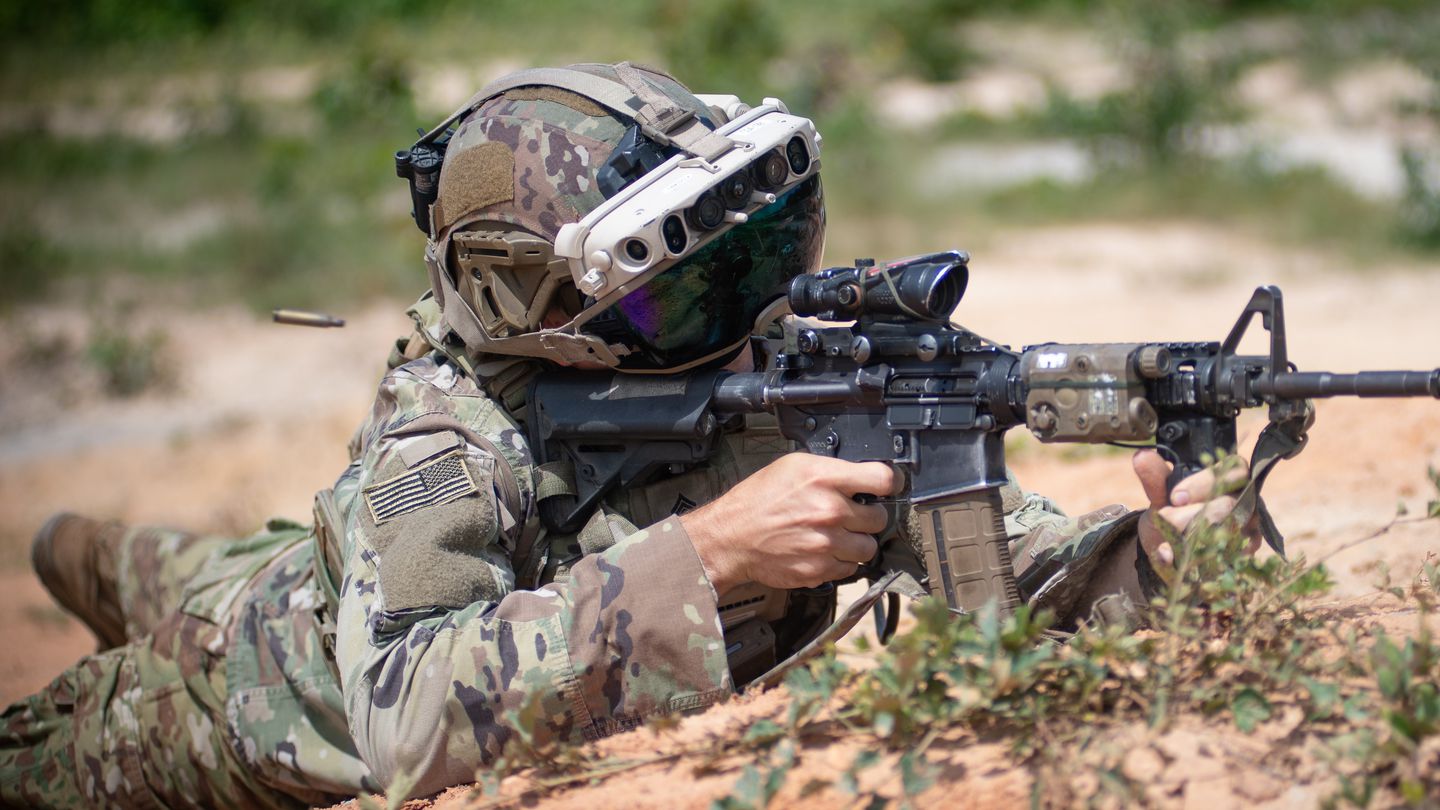FORT BELVOIR, Va. – The newest version of the Army’s mixed reality goggle that seeks to provide all-encompassing situational awareness to the dismounted soldier will feature a slimmer design, more outdoor functions and possibly a wireless controller.
The Integrated Visual Augmentation System is a melding of night vision and a host of tools including navigation, communication, training rehearsals and recording features for instant replay to review a soldier’s performance.
The service approved a task order for the technology company Microsoft in December that allowed for continued development of the 1.2 version of the goggle. The Army is using the base technology of the company’s civilian market HoloLens headset to build the platform.
RELATED
:quality(70)/cloudfront-us-east-1.images.arcpublishing.com/archetype/7OQIJOMDVBAA3HWBIDHZ2AU7OU.jpg)
The Army already purchased 5,000 sets each of the 1.0 and 1.1 versions last year as part of what is expected to be at least a $22 billion program.
The standing budget request to Congress asks for $165 million in fiscal 2024. That’s split between $76 million for developing 1.2 and $89 million for procurement, according to budget documents released in March.
Those earlier models are slated for delivery in early fiscal 2024 to training and deploying units. Developers are pushing ahead with 1.2 work while which will include two phases and a series of soldier feedback sessions.
The 1.2 Phase 1 development will undergo a series of soldier assessments before an operational test scheduled for fiscal 2025. Phase 2, which involves device development is also scheduled to end in late fiscal 2025 for operational testing and fielding by the end of fiscal 2025.
PEO Soldier staff showed a demonstration model of the still-developing 1.2 version to Army Times along with new elements available in the 1.1 version that have been added since previously demonstrated soldier touch points.
The device previously featured a chest-mounted combined controller and computer. But the 1.2 variant has the controller separate from the computer. The controller can be moved anywhere on the upper torso while the computer is now mounted on the rear of the helmet.
That’s helpful to counterbalance the front weight of the device and reduce neck strain, also now helmet-mounted in version 1.2, said Lt. Col. Denny Dresch, IVAS product manager.
Early total goggle variants weighed about 3.4 pounds, with 2.4 pounds of that on the front of the helmet. The total target weight for the 1.2 device is 2.85 pounds, equal to the currently fielded Enhanced Night Vision Goggle-Binocular.
Other ongoing improvements include better eye relief, weapons compatibility, air flow, processing software and a display that provides peripheral vision.
A major feature included the addition of color-coded navigation points and other map-marking features viewable in the goggle either in map format or in the rotating compass headings in “sight” on the user’s upper view.
On a 20-minute walk outside of the PEO Soldier’s Soldier Integration Facility, the user was able to select features, drop points on a virtual map and track the entire route while communicating with another goggle user.
Users can also build a virtual sand table of terrain, a building complex or whatever feature they face on an upcoming mission.
No more Lego bricks or MRE boxes to build a “map” of the objective.
Inside the building, development team members highlighted training features that included tracking the goggle wearer through a simulated shoot house. The shooting scenarios featured thin office cubicle-style walls. Inside the goggle, however, images of enemy combatants, civilians and even a dog presented shoot house scenarios and challenges that are familiar to many who trained or deployed in the Army in recent decades.
But it was after the training that some of the features showed iterative promise, what officials called “training at the point of need.”
The devices record location and actions of shooters. Viewers can watch an “instant replay” of their moves, shots and hits play out, pausing to examine where a barrel was pointed or who shot first.
Sorry soldiers, no more “tall tales” on your shoot house performance. It’s all captured for posterity, and improved training, now.
Multiple reports from soldier touchpoints have shown that some soldiers get dizzy or nauseous when using the device. That’s common in virtual reality goggles and augmented reality use across the spectrum.
The Army has formed a special team to solve that queasy problem.
Teams from industry, government and academia are examining feedback from soldier use and pulling in lessons learned from other high-tech efforts. Think of jet fighter pilots hitting G-forces or medics working with tablet screens while treating patients in a medevac helicopter.
Those partners include Microsoft Visual Sciences, Engineering and Human Factors Team, independent consultants, Soldier Systems Branch from the Army Test & Evaluation Command and experts with the Engineering Psychology Department of Behavioral Sciences & Leadership at the U.S. Military Academy at West Point, among others.
As those 1.2 tests and experiments move forward, the developers with Program Executive Office Soldier and Simulation, Training and Instrumentation along with teams at the Army Futures Command will harvest added feedback from the rollout of 1.0 and 1.1.
The fiscal 2024 rollout was delayed by at least three months from earlier targets of late fiscal 23. However the delay this time is not due to a technology challenge but instead a shift in funding priorities under the currently proposed fiscal 2024 budget, officials told Army Times.
Earlier delays pushed delivery of the earlier variants due to image distortion problems. A reduced field of view, which still exceeds the existing night vision field of view, along with software fixes resolved early hurdles with image distortion.
Another challenge developers faced was including an improved low-light sensor for night vision that would equal the recently fielded Enhanced Night Vision-Binocular device.
While the mixed reality goggle’s early versions already produce night vision that exceeds legacy fielded systems, the image quality on the device didn’t match the newly fielded gear.
That’s in part because the developers are melding digital information using augmented reality with new forms of night vision, pushing technology developed over 70 years to new levels, Brig. Gen. Christopher Schneider previously told Army Times.
Todd South has written about crime, courts, government and the military for multiple publications since 2004 and was named a 2014 Pulitzer finalist for a co-written project on witness intimidation. Todd is a Marine veteran of the Iraq War.

